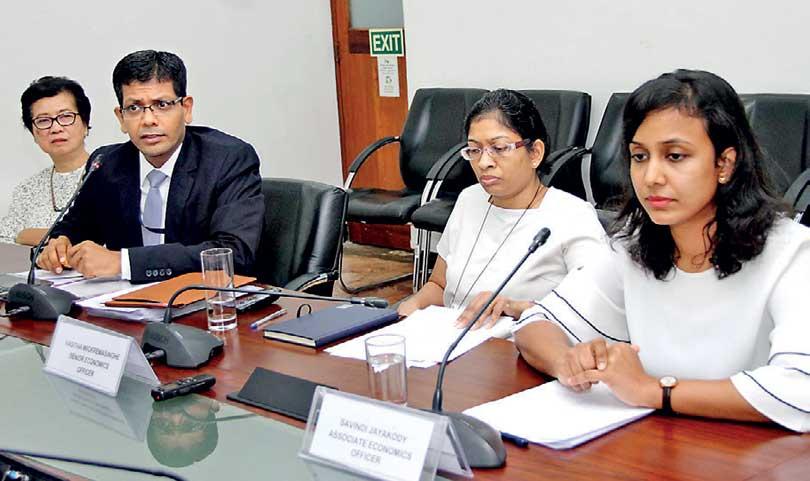05 Apr 2019 - {{hitsCtrl.values.hits}}

From left: ADB Country Director Sri Widowati, Senior Country Economist Utsav Kumar, Senior Economics Officer Hasitha Wickremasinghe and Associate Economic Officer Savindi Jayakody
Pic by Pradeep Dilruckshana
By Indika Sakalasooriya
The Asian Development Bank yesterday made a rather optimistic forecast on Sri Lanka’s economic growth for this year and the next, although the development lender admitted the ongoing scheduled power cuts and freak weather haven’t been factored into the growth numbers.
Releasing its flagship Asian Development Outlook (ADO) 2019 report, ADB said Sri Lanka’s growth is expected to pick up to 3.6 percent this year and then to 3.8 percent in 2020.
Sri Lanka’s economy slowed down to 3.2 percent in 2018 as calamitous political developments—specially during the latter part of the year—weighed on the economic sentiment, which resulted in the fourth quarter registering a dismal growth rate of 1.8 percent.
Senior Country Economist at ADB’s Sri Lanka Resident Mission, Utsav Kumar, expects a turnaround in manufacturing and construction sector performance to drive growth this year and the pickup in agricultural activities in 2018 to continue into this year barring adverse weather. “Supported by a low base and higher budget for public investments, the construction sector is expected to show an improvement in 2019 as well as 2020,” Kumar told reporters in Colombo. He also said the 2019 budget proposal to increase government sector salaries and address pension anomalies would support private expenditure and consumption and thereby growth.
“While the economy is projected to recover over the next two years, for Sri Lanka to sustain and accelerate growth, fiscal and structural reforms remain essential. Addressing policy constraints will be critical to avoiding repeated macroeconomic pressures and to generating sustained sources of foreign exchange earnings.” Kumar said.
ADB expects inflation to pick pace with increased economic activity with weak currency exerting upward pressure on the prices. Inflation is expected to edge up to 3.5 percent in 2019 and then reach 4.0 percent in 2020.
The development lender also expects the current account deficit to drop to 2.5 percent of GDP this year on recovery in agricultural exports, continued increase in tourist earnings and a slowdown in vehicle imports.
Meanwhile, highlighting the global risks that may influence the growth of Asian economies, ADB’s Regional Economic Officer Lei Lei Song said risks stemming from global financial volatility would likely to continue to impact emerging and frontier market currencies in 2019 and 2020.
Amid fund outflows due to US Fed rate hikes and political uncertainty, Sri Lankan rupee depreciated almost 20 percent in 2018. However, with the improvement in political environment despite the impending crucial election by end of this year, and the slowing of US rate increases, the rupee has appreciated over four percent so far this year.
Meanwhile, ADO 2019 identifies recurrent weather-related disasters as a key risk for Sri Lanka’s economic growth as they severely hit the agriculture sector, which employs close to 2.1 million people in the country’s labour force. ADB Sri Lanka Resident Mission’s Associate Economic Officer Savindi Jayakody pointed out the need to develop a preemptive strategy to deal with these recurrent weather-related disasters in future while promptly helping the affected in post-disaster situations. She also noted that about 56 percent of Disaster Management Ministry’s budget allocation goes for post-disaster relief measures and only one fourth of that allocation is utilized for mitigation activities.
15 Nov 2024 35 minute ago
15 Nov 2024 1 hours ago
15 Nov 2024 2 hours ago
15 Nov 2024 2 hours ago
15 Nov 2024 2 hours ago